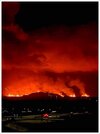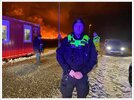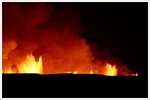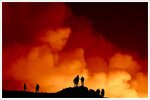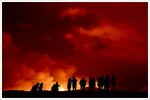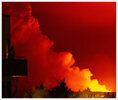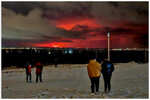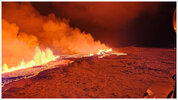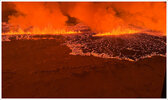It's hard to tell whether Mother Earth is smoking cigarettes or doing EE. As she exhales, toxins are getting out no matter what.The Reykjanes volcano in southwest Iceland erupted on Monday, spewing lava and smoke into the air, after weeks of intense earthquake activity, the country's Meteorological Office said.
You are using an out of date browser. It may not display this or other websites correctly.
You should upgrade or use an alternative browser.
You should upgrade or use an alternative browser.
Volcanoes Erupting All Over
- Thread starter Laura
- Start date
This video is extraordinary, massive eruption near Grindavik. Scary scene for the area...there is an Aurora coloring the sky green that is suddenly overshadowed by the color of the fire.
VOLCANIC ERUPTION IN ICELAND: The Grindavík volcano on Iceland’s Reykjanes peninsula is erupting following an earthquake on Dec. 18th. It is only 4.5 miles from the Geldingadalur volcano, which erupted in 2021 and produced a viral aurora photo.

Geologists and meteorologists are working now to evaluate the size of the blast and how much gas/dust it pumped into the atmosphere.
#Guatemala
Eruptive pulse of Santiaguito volcano captured yesterday from Siete Orejas hill, in #Quetzaltenango (Dec 28, 2023).
Mount Lewotobi Eruption East Flores
East Nusa Tenggara
Strong explosion records Mount Dukono Volcano of Halmahera Island, #Indonesia (January 03, 2024).
Another possible eruption.
Suwanosejima volcano has erupted, spewing rocks one kilometer into the sky.

 www3.nhk.or.jp
14 hours ago
www3.nhk.or.jp
14 hours ago

Japan Meteorological Agency raises volcanic alert level for Suwanosejima island | NHK WORLD-JAPAN News
Japan's Meteorological Agency says a volcanic eruption has occurred on the island of Suwanosejima, which is located in southwestern Japan's Kagoshima Prefecture.
 www3.nhk.or.jp
www3.nhk.or.jp
XPan
The Living Force
14 Jan 2023
An eruption has begun just outside north of Grindavík at 07.57 local icelandic time. The lava flow os likely to flood the outskirts; the northern parts of the town. The eruption is significantly smaller than the one from Dec 2023.

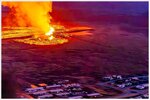
ibl.is writes:

Worth the effort to try to delay the lava
"It is well worth trying to delay this as much as possible, with the methods that can be used." It can save something - we don't know - but it's worth the effort," says Magnús Tumi Guðmundsson, professor of geophysics at the University of Iceland, in an interview with mbl.is about the state of affairs in Grindavík due to the eruption that began this morning.Building dikes close to the settlement in Grindavík has been under consideration to protect the town and direct the lava flow elsewhere.
A quarter of the previous eruption but the same fissure
"The eruption started at eight o'clock and the fissure is a continuation of the fissure where the eruption started on December 18, but is much further south." The southernmost part crosses the ramparts that were being built and extends about 200 meters south of them. The crack is about kilometers long and a rough estimate is that it is about a quarter as intense as it was in December," explains Magnús Tumi."After two hours, only about half a kilometer was needed for the lava flow to reach the northernmost houses in Grindavík, but it is questionable how this will develop. It usually reduces eruptions quite quickly, but we have yet to see how this develops," he says.
The gardens were useful
The defenses that were being built north of Grindavík are beneficial, according to Magnús Tuma, who points out that the majority of the magma is coming up north of the gardens, which directs the lava flow to the west, while part of the magma is coming up south of the gardens and is heading for residential areas.However, it remains to be seen how much the dikes manage to divert lava from the town and it depends on how long the eruption lasts. He points out that in the vast majority of volcanic eruptions activity decreases immediately after the eruption begins and there is every chance that this eruption will behave the same way.
"The question is how long this will last and how fast it will decrease, we just don't know that at the moment."
According to Magnús Tuma, there is only one thing in the situation, in view of reducing the eruption activity.
"It's trying to do as much as possible to make some obstructions and delay the lava. Looks like it's very worth it. Each house is maybe about 100 million besides the emotional damage that happens when their house goes under lava. It faces the need to do everything possible to reduce the damage."
Víðir says that people have noticed a lot of subsidence in the town and new cracks have formed.
Huge landslides and new cracks have formed in the town
"We clearly see new cracks and we have heard from the utility companies that pipes have broken. We see clear signs of cracks expanding and new ones forming. There was considerable deformation in the town last night in these events that took place before the eruption began," says Víðir.It was possible to get all the machines from the defenses and Víðir says that the work went well.
"Fortunately, the equipment was up on the dike and they are all at work in defensive operations around the pipes and extending the dike over Grindavíkurveðin. The job of removing the work tools was well prepared and the guard's helicopter was in the area to monitor," says Víðir.
The Civil Defense wants to urge people not to try to approach the eruption centers in any way.
"This is the most serious eruption that has occurred in Iceland since it erupted in Vestmannaeyjar in 1973, and as the situation in Grindavík is now, it is a very dangerous place. We don't have any personnel there and there will be no operations inside the town while the situation is this way."
Last edited:
Crazy vids of a new Grindavik fissure that has begun to destroy structures.
And some various comments of officials and locals:

 www.mirror.co.uk
www.mirror.co.uk
And some various comments of officials and locals:

Iceland town without water or power after houses engulfed by lava - live updates
Multiple houses were hit by molten-hot lava after a volcano erupted in Iceland’s Reykjanes peninsula on Sunday, located north of the southwestern Icelandic town of Grindavik
'No one going into Grindavik' says Civil Defence chief
Víðir Reynisson, head of Civil Defence, has told Iceland media that "no one is going into Grindavík until we are absolutely sure that it will be OK".
The town has been entirely evacuated although there are deep concerns for farm animals and some pets which may still be there. A total of three houses have been seen catching fire.
Eruption 'worst event of its kind in half a century'
Iceland's head of Civil Defence has labelled the eruption the country's most serious event of its kind in more than 50 years.
Víðir Reynisson said the last eruption on this scale was in January 1973. He said: "Today's events are such that they will be long remembered, and we are probably just seeing the beginning of a chain of events that will continue and be difficult to deal with."
Response team's work went well, say police
Úlfar Lúðvíksson, police chief in Suðurnes, says that all the work of the response teams went well today, despite the scale of the disaster.
He says work has continued today on the construction of the protective walls, and they have already proven their worth by diverting some of the lava flow away from the town.
'More fissures could open'
Lava is still flowing towards Grindavik this evening, while the risk of more issures opening 'cannot be ruled out', Iceland's Meteorological Office has said.
Three houses have now caught fire since the eruption. Lovísa Mjöll Guðmundsdóttir, a natural hazard expert for the service, said the situation however seemed to be "stabilising".
GPS data taken at 1pm GMT showed a lot of deformation in the area, although this has since reduced slightly.
Grindavik restaurant owner 'flabbergasted' eruption 'is possible under town'
A Grindavik restauranteuer says he is in disbelief that an eruption could occur under the town of Grindavik.
Olafur Arndal was at home when he received instructions from the Icelandic authorities to get to safety - but has since expressed his shock at the events of the day.
Speaking to Eurovision News (EVN), he said: "I'm flabbergasted that an eruption is possible under the town. That's something I can't believe. We were waiting for an eruption up on the mountain but not underneath the town... Nobody knows what happens."
XPan
The Living Force
Grindavík Fissures, Iceland
15 Jan 2023
Indeed like iamthatis reported, several structures (homes) have been destroyed in the northern part of Grindavík town - at the same time, it now seems that the smaller fissure (which had opened up just north of the houses), has given up.
Here are some photos from last night/ early this morning from North Grindavík

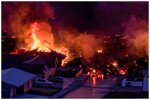
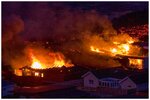
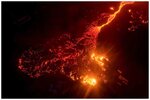
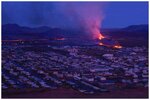
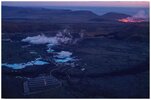
This view shows the eruption seen from the Blue Lagoon / Svartsengi powerplant.
Vísir (15 Jan 2023, 03.07 local Icelandic time) reports following:
Lava flows within the town limits, fades away
"It seems to us that the southern fissure, which is within the city limits, is completely giving up," says Elísabet Pálmadóttir, a natural disaster expert at the Icelandic Meteorological Office, in an interview with a news agency.
"There are spews that just reach the surface every now and then. But there is very little activity, so it seems to me that it is fading away now."
At the same time, Elisabeth says that, as a result, the flow of lava from that fissure has also stopped. Lava from the fissure has caused fires in three houses in Grindavík. It seems that the lava has reached the fence to the garden of the fourth building.
The southern fissure has been considerably smaller than the one to the north, but since it was formed within a fortification that was supposed to protect Grindavík, it has threatened the settlement considerably more. As mentioned before, the lava flow from it has already caused a lot of damage in Grindavík, with fires in three houses.
Élisabet says that the Icelandic Meteorological Agency noticed work in the western part of Grindavík last night, where the other lava flow could start to threaten. "It's a bit of a stretch, but they've worked hard tonight." They try to put up some defenses there."
When asked if the closure of the southern fissure has anything to say about the likelihood of new eruptions in this event, Elisabeth says it is difficult to say.

a 3D model shows the eruption centers
The Natural Institute of Iceland and the Land Survey of Iceland have published 3D models of the eruption area at Sundhnúksgíga.
It was a so-called image measurement team that worked on the model, which is based on footage taken from an airplane and measured in the program Agisoft Metashape.
The model, which was developed in collaboration with Almannavarnin and the University of Iceland, shows the eruption centers as they were at 16:20 today, Sunday.
On the model you can see the fire that has occurred in a settlement in Grindavík due to the second crack that opened around noon today just a short distance from the town.

 www-visir-is.translate.goog
www-visir-is.translate.goog
15 Jan 2023
Indeed like iamthatis reported, several structures (homes) have been destroyed in the northern part of Grindavík town - at the same time, it now seems that the smaller fissure (which had opened up just north of the houses), has given up.
Here are some photos from last night/ early this morning from North Grindavík






This view shows the eruption seen from the Blue Lagoon / Svartsengi powerplant.
Vísir (15 Jan 2023, 03.07 local Icelandic time) reports following:
Lava flows within the town limits, fades away
"It seems to us that the southern fissure, which is within the city limits, is completely giving up," says Elísabet Pálmadóttir, a natural disaster expert at the Icelandic Meteorological Office, in an interview with a news agency.
"There are spews that just reach the surface every now and then. But there is very little activity, so it seems to me that it is fading away now."
At the same time, Elisabeth says that, as a result, the flow of lava from that fissure has also stopped. Lava from the fissure has caused fires in three houses in Grindavík. It seems that the lava has reached the fence to the garden of the fourth building.
The southern fissure has been considerably smaller than the one to the north, but since it was formed within a fortification that was supposed to protect Grindavík, it has threatened the settlement considerably more. As mentioned before, the lava flow from it has already caused a lot of damage in Grindavík, with fires in three houses.
Élisabet says that the Icelandic Meteorological Agency noticed work in the western part of Grindavík last night, where the other lava flow could start to threaten. "It's a bit of a stretch, but they've worked hard tonight." They try to put up some defenses there."
When asked if the closure of the southern fissure has anything to say about the likelihood of new eruptions in this event, Elisabeth says it is difficult to say.

a 3D model shows the eruption centers
The Natural Institute of Iceland and the Land Survey of Iceland have published 3D models of the eruption area at Sundhnúksgíga.
It was a so-called image measurement team that worked on the model, which is based on footage taken from an airplane and measured in the program Agisoft Metashape.
The model, which was developed in collaboration with Almannavarnin and the University of Iceland, shows the eruption centers as they were at 16:20 today, Sunday.
On the model you can see the fire that has occurred in a settlement in Grindavík due to the second crack that opened around noon today just a short distance from the town.

Þrívíddarlíkan sýnir gosstöðvarnar - Vísir
Náttúrufræðistofnun Íslands og Landmælingar Íslands hafa birt þrívíddarlíkön af gossvæðinu við Sundhnúksgíga.
XPan
The Living Force
Additional info, charts and images
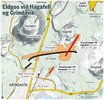
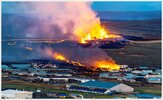
mbl.is writes
(15 Jan 2024, 08.10 local Icelandic time)
The lava flows not with the same speed as yesterday
The lava flow from the southern fissure seems to have mostly or completely stopped, and the flow from the northern fissure seems to have slowed somewhat. This is what Hördís Guðmundsdóttir, information representative of the civil defense, says. Work has been done last night to expand the rampart at Grindavík to the west and raise it at Nesveg.
At 10:00 a.m. today, scientists will discuss the situation, and in the future, the civil defense will review the situation, among other things, taking into account whether there is a possibility of salvaging valuables into Grindavík.
The police and other responders are monitoring the situation both from web cameras, but also from a drone that a group of drones has sent on regular tours of the area. Hjördís says it has saved numerous helicopter trips and provided an invaluable view for emergency responders.
Hjördís notes that there is a reason why not a soul was allowed into the town yesterday. "We don't know anything about how the Earth behaves despite some knowledge of this."
As mentioned earlier, the daily meeting of scientists will now take place at 9:30 am.
Hjördís says that in the publication it will also be revealed how the rampart was raised to the west along Nesvegi, but it is intended to protect the town from lava flows from the northern fissure that has flowed west along the rampart that was erected.
She says that in publication it will also be revealed what the speed of the lava is and whether the existing parks should be sufficient.
END OF ARTICLE

 www-mbl-is.translate.goog
www-mbl-is.translate.goog
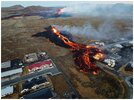
Lava from the southern fissure flowed outside the town limits and over three houses and is on the property boundary of the fourth. Now, however, it seems as if the flow from the fissure has stopped. mbl.is/Kristinn Magnússon
The flow of lava from the southern fissure at Grindavík seems to have stopped
and with it the continued flow of lava into the town limits. Three houses appear to have been hit by the lava so far. However, the northern fissure still seems to have a similar flow as yesterday. This is what Böðvar Sveinsson, a natural disaster expert at the Icelandic Meteorological Office, says.
Lava is at the boundary of the fourth house, which is no. 20, but it stands on the street Efrahóp. Earlier last night, a natural disaster expert told mbl.is that small spits still came to the surface every now and then, but now it seems to be over.
According to Böðvar, unrest has decreased slightly, but it is still small and it is not possible to tell its significance right away.
The Norwegian Meteorological Agency uses both web cameras and drone shots provided by rescue teams during the night. He says that according to that, the southern fissure now appears dead and there is no lava flow from the fissure. However, this will become clearer when it is published.
Regarding magma inflow into the upper magma chamber, Böðvar says that it is difficult to say and that further measurements will be made today by the deformation experts of the Norwegian Meteorological Agency.
There is still earthquake activity at the eruption centers, but Böðvar says that some of the earthquakes that appear on the map on the Norwegian Meteorological Agency's website are unsurpassed earthquakes that are not real earthquakes.
END OF SECOND ARTICLE

 www-mbl-is.translate.goog
www-mbl-is.translate.goog


mbl.is writes
(15 Jan 2024, 08.10 local Icelandic time)
The lava flows not with the same speed as yesterday
The lava flow from the southern fissure seems to have mostly or completely stopped, and the flow from the northern fissure seems to have slowed somewhat. This is what Hördís Guðmundsdóttir, information representative of the civil defense, says. Work has been done last night to expand the rampart at Grindavík to the west and raise it at Nesveg.
At 10:00 a.m. today, scientists will discuss the situation, and in the future, the civil defense will review the situation, among other things, taking into account whether there is a possibility of salvaging valuables into Grindavík.
Increases hope for value recovery
Hjördís says the good news that the lava flow has slowed down increases the hope that valuables can be salvaged. She notes, however, that although it seems that the flow has slowed down, it will not be properly seen until publication.The police and other responders are monitoring the situation both from web cameras, but also from a drone that a group of drones has sent on regular tours of the area. Hjördís says it has saved numerous helicopter trips and provided an invaluable view for emergency responders.
Take the situation after the meeting of scientists
Hot water went out of town yesterday after lava flowed over a hot water pipe from Svartsengi, and there was also a power outage in the town. Asked if she expects residents to be able to get to their homes today to save valuables or try to limit damage, she says that it is today's task to look at what will be done.Hjördís notes that there is a reason why not a soul was allowed into the town yesterday. "We don't know anything about how the Earth behaves despite some knowledge of this."
As mentioned earlier, the daily meeting of scientists will now take place at 9:30 am.
Hjördís says that in the publication it will also be revealed how the rampart was raised to the west along Nesvegi, but it is intended to protect the town from lava flows from the northern fissure that has flowed west along the rampart that was erected.
She says that in publication it will also be revealed what the speed of the lava is and whether the existing parks should be sufficient.
END OF ARTICLE

Hraunflæðið ekki með sama hraða og í gær
Hraunflæðið úr syðri sprungunni virðist að mestu eða öllu leyti hætta og eitthvað virðist hafa dregið úr rennsli úr nyrðri sprungunni. Þetta segir Hördís Guðmundsdóttir, upplýsingafulltrúi almannavarna. Unnið hefur verið í nótt að því að stækka varnargarðinn við Grindavík að vestan og hækka við...

Lava from the southern fissure flowed outside the town limits and over three houses and is on the property boundary of the fourth. Now, however, it seems as if the flow from the fissure has stopped. mbl.is/Kristinn Magnússon
The flow of lava from the southern fissure at Grindavík seems to have stopped
and with it the continued flow of lava into the town limits. Three houses appear to have been hit by the lava so far. However, the northern fissure still seems to have a similar flow as yesterday. This is what Böðvar Sveinsson, a natural disaster expert at the Icelandic Meteorological Office, says.
Lava is at the boundary of the fourth house, which is no. 20, but it stands on the street Efrahóp. Earlier last night, a natural disaster expert told mbl.is that small spits still came to the surface every now and then, but now it seems to be over.
According to Böðvar, unrest has decreased slightly, but it is still small and it is not possible to tell its significance right away.
The Norwegian Meteorological Agency uses both web cameras and drone shots provided by rescue teams during the night. He says that according to that, the southern fissure now appears dead and there is no lava flow from the fissure. However, this will become clearer when it is published.
Regarding magma inflow into the upper magma chamber, Böðvar says that it is difficult to say and that further measurements will be made today by the deformation experts of the Norwegian Meteorological Agency.
There is still earthquake activity at the eruption centers, but Böðvar says that some of the earthquakes that appear on the map on the Norwegian Meteorological Agency's website are unsurpassed earthquakes that are not real earthquakes.
END OF SECOND ARTICLE

Ekkert hraunstreymi lengur úr syðri sprungunni
Hraunstreymi úr syðri sprungunni við Grindavík virðist hafa stöðvast og þar með áframhaldandi hraunflæði inn fyrir bæjarmörkin. Þrjú hús virðast hafa orðið fyrir hrauninu hingað til. Nyrðri sprungan virðist þó áfram vera með svipað flæði og í gær.


